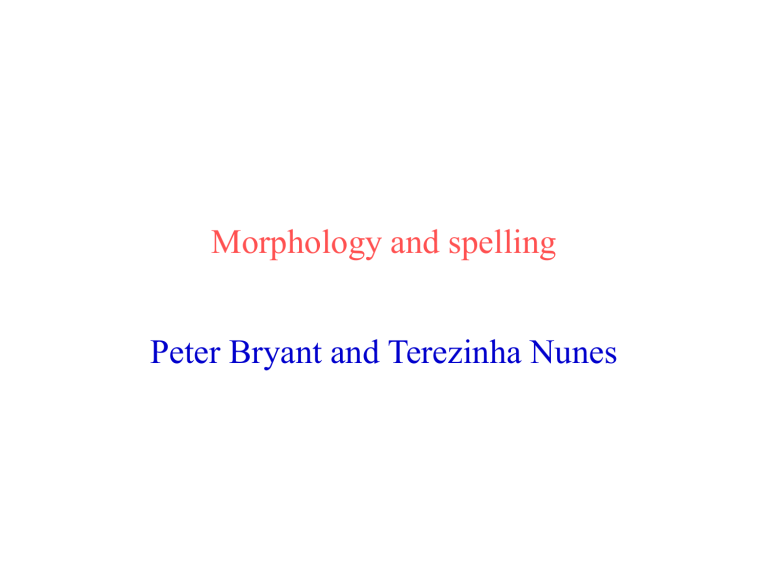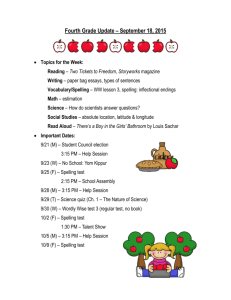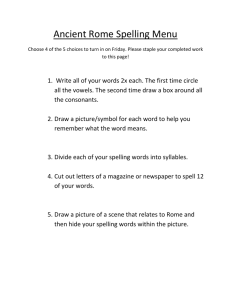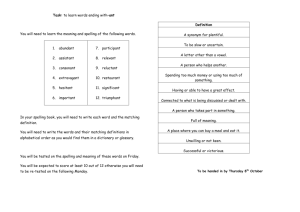Beyond grapheme-phoneme correspondences

Morphology and spelling
Peter Bryant and Terezinha Nunes
Unputdownable morphemes
Morphemes are units of meaning and many words are constructed from more than one morpheme
1. glad
2.
gladly, gladness
3.
4.
read put readable put down unreadable putdownable unputdownable
The spelling of affix morphemes (ly, -ness, able ) is highly consistent and therefore regular in
English as well as in other languages
Conditional morphological spelling rules exist in many orthographies (French, English, Greek,
Portuguese, Hebrew, Arabic) when:
the same sound is spelled in different ways fox sock s educat ion
δίνω magic ian
νερό
different sounds are spelled in the same way cat s dog s heal heal th
spelling represents morphemic distinctions that aren’t represented in speech la maison les maison s
The boys drink The boy
’s drink
bins
Three questions
Do children have particular difficulty in conforming to these morphemic rules in spelling?
What causes these difficulties?
Do children overcome these difficulties by learning about morphemic spelling rules or in some other way?
Three questions
Do children have particular difficulty in conforming to these morphemic rules in spelling?
What causes these difficulties?
Do children overcome these difficulties by learning about morphemic spelling rules or in some other way?
Phonemes, not morphemes, in invented spelling
(substitution for past verb “ed” ending)
halpt
likt helped liked
kild
watid
wotid killed waited wanted
Charles Read, 1986
“s” or “z” for plurals in invented spelling
onges
boxis oranges boxes
pnnez
disaz
owsenz pennies dishes oceans
Charles Read, 1986
Spelling the endings of /d/ and /t/ non-verbs
/d/ ending /t/ ending bird cold field belt except next gold paint ground soft
Nunes, Bryant & Bindman
Mean correct phonetic spellings of non-verbs ending in /d/ or /t/ (out of 10) in 3 sessions over a period of 21 months
10
9
8
7
6
5
4
3
2
1
0
6yr5m 7yr5m
Nunes, Bryant & Bindman
8yr7m start
7m later
21m later
N=297
Spelling the endings of regular past verbs with
/d/ and /t/ inflections
/d/ ending /t/ ending called dressed covered kissed filled killed opened laughed learned stopped
10
9
6
5
8
7
4
3
2
1
0
Mean correct “-ed” spellings (out of 10) in 3 sessions over a period of 21 months
6yr5m 7yr5m 8yr7m start
7m later
21m later
N=297
Nunes, Bryant & Bindman
Phonetic endings instead of the correct
“-ed” ending
Number of incorrect
most of the mistakes with regular verb endings are phonetic transcriptions: e.g.
“ kist
” for “ kissed
”
these inappropriate phonetic transcriptions are made even by some 10 year olds phonetic transcriptions of regular verb endings
3
2
1
0
5
4
10
9
8
7
6
6 7 8 9 10
Generalisations and overgeneralisations of the
“-ed” ending
many children put “-eds” on the ends of irregular past verbs ( sleped ) (71%), and also of non-verbs
( sofed, necsed ) (59%) as well as of regular past verbs ( kissed )
the generalisation to irregular verbs is incorrect but grammatically appropriate
the generalisation to non-verbs is incorrect and inappropriate grammatically
Nunes, Bryant & Bindman
Incorrect generalisations of the “ed” ending to irregular verbs “sleped” & to non-verbs “necsed”
at first the children make the two types of generalisation roughly equally
but by 8 yrs they make many more generalisations to irregular verbs than to non-verbs
1
0.9
0.8
0.7
0.6
0.5
0.4
0.3
0.2
0.1
0
6yr s
8yr s
10yr s to nonverbs to irreg vbs
Nunes, Bryant & Bindman
/d/ and /t/ endings are spelled as “d” and “t” grapheme-phoneme rule
/d/ and /t/ endings are sometimes spelled as “d” and “t” and sometimes as “ed” extension of grapheme-phoneme rule
“ed” endings are for past verbs:
“d” and “t” endings are for everything else morpho-phonemic rule
20
10
0
50
40
30
100
90
80
70
60
The –ion ending: how 880 children spelled four words with the “-t-ion” ending: percent correct election destination combination emotion
7 to 8 8 to 9 9 to 10 10 to 11
Sound in real word stems
Sound in real word inflections
/o/sound
τόπι(ball)
φωνή(voice)
νερό(water)
δίνω(I give)
μιλάμε(we talk) παιδί(child)
/i/ sound
μήλο(apple) πόλη(town)
μιλάμε (we talk)
δίνω (I give)
φιλώ (I kiss)
ρίχνομαι (I fly into)
ψήνει (s/he cooks)
μήλο (apple)
κήποι (gardens)
νησί (island)
κλείνομαι (I am shut up in)
θείοι (uncles)
δείχνουμε (we show)
πειράζει (s/he teases)
τόπι (ball)
παιδί (child)
βόδι (ox)
νησί (island)
ζώνη (waistband)
πόλη (town)
θέση (place/seat)
φωνή (voice)
ψήνει (s/he cooks)
δένει (s/he ties)
πειράζει (s/he teases)
κοιτάζει (s/he looks at)
κοιμάμαι (I sleep)
τοίχοι (walls)
κοιτάζει (s/he looks at)
ανοίγουμε (we open)
τοίχοι (walls)
θείοι (uncles)
κήποι (gardens)
καιροί (days/times)
θότι
νεπί
σόβι
κιφί
λόχη
κόση
ρέκη
βοπή
πέφει
γίβει
σιφάγει
διπάγει
λίροι
μίοι
νίγοι
σεποί
16
14
12
10
8
6
4
2
0
32
30
28
26
24
22
20
18
Session A (Mean age:
6y10m)
Session B (Mean age:
7y6m)
Real Word Stems
Real Word Inflections
Pseudoword Inflections
Session C (Mean age:
8y6m)
Chliounaki & Bryant, 2008
Answer to first question
The conditional rules are seriously and persistently difficult for a lot of children
The degree of difficulty may vary from script to script
Three questions
Do children have particular difficulty in conforming to these morphemic rules in spelling?
What causes these difficulties?
Do children overcome these difficulties by learning about morphemic spelling rules or in some other way?
Three questions
Do children have particular difficulty in conforming to these morphemic rules in spelling?
What causes these difficulties?
Do children overcome these difficulties by learning about morphemic spelling rules or in some other way?
Not enough explicit morphological awareness?
Several studies with English speaking children show a relationship between children’s morphological awareness and their use of conventional spelling for inflections
We ourselves have used 2 main tasks to establish this relationship
Two morphological awareness tasks
Sentence analogy: Word analogy:
Tom helps Mary
Tom helped Mary
Tom sees Mary
_____________ teacher taught writer ______ walk walked shake ______
Word analogy predicts correct use of “ed” 7 months later:
Outcome measure - spelling “ed”s 7 months after the 1st session
Word analogy in 1st session
4. 0%
Nunes, Bryant,
& Bindman
Spelling “ed”s in
1st session
8.0%
IQ
11.1%
Age
13.8%
How general is the link?
Several researchers have found this predictive relationship in English-speaking children (e.g. Kirby
& Deacon in Canada) and it seems to be true of
Israeli (Levin) and Brazilian (Rego) children too
It is likely that it’s a 2-way street (Levin; \Nunes &
Bryant)
But it may not be true of orthographies in which spelling is not conditional on morphology e.g.
Finnish
A test of spelling geminates and consonant clusters given to Finnish 7-year olds
Geminates Clusters
Stem prinseSSaksi kimaLLukseksi harraSTuksena puhaLTamiseksi
Inflection tilaisuudeSSa kumppaniLLa
älykkyydeSTä lasketteluLTa
This task was given to the children at mean age 7 yrs (Time 1) and 5 months later at mean age 7yrs 5m (Time 2)
Lehtonen & Bryant, 2005
Morphological awareness and spelling geminates
& clusters
At Time 1 & 2 we also gave the children a Finnish version of Berko’s Wug task, devised by Lyytinen
(1988)
We used the adverb, comparative and past tense subtests
Our question was whether these scores would predict spelling of inflections more than of stems
There was no difference: the correlation between the morphological test at Time 1 and spelling at Time 2 was .48 for stem spelling and .41 for inflection spelling
Answer to second question
Children may ignore morphological spelling rules because they are not explicitly aware enough of morphological categories and morphological distinctions
It’s likely that they concentrate on phonology instead because that’s what they’re taught about
Three questions
Do children have particular difficulty in conforming to these morphemic rules in spelling?
What causes these difficulties?
Do children overcome these difficulties by learning about morphemic spelling rules or in some other way?
Three questions
Do children have particular difficulty in conforming to these morphemic rules in spelling?
What causes these difficulties?
Do children overcome these difficulties by learning about morphemic spelling rules or in some other way?
Morphemic spelling rules exist
……..
But do people who eventually learn to spell words using the conventional spellings for morphemes actually know and use the rules?
The alternative is that they learn the specific spelling of each word (“word specific” or “lexical” learning), or that they learn about a set of specific sequences
The acid test is to present children with pseudo words which have an obvious morphemic structure e.g. “Yesterday I /bopt/ along the road as I went to school”
A study of Greek children’s learning of how to spell vowel sounds in inflections and in stems
The best evidence that children actually learn morphemic spelling rules comes from Greek
Greek is a highly regular orthography as far as reading is concerned
Spelling is less predictable because there are very few vowel sounds in Greek, and more than one way of spelling three of the vowels
e.g. /i/ is represented by:
ι , η
,
ει, οι
/o/ is represented by:
ο , ω
/e/ is represented by:
ε , αι
μιλάμε (we talk)
δίνω (I give)
φιλώ (I kiss)
ρίχνομαι (I fly into)
ψήνει (s/he cooks)
μήλο (apple)
κήποι (gardens)
νησί (island)
κλείνομαι (I am shut up in)
θείοι (uncles)
δείχνουμε (we show)
πειράζει (s/he teases)
τόπι (ball)
παιδί (child)
βόδι (ox)
νησί (island)
ζώνη (waistband)
πόλη (town)
θέση (place/seat)
φωνή (voice)
ψήνει (s/he cooks)
δένει (s/he ties)
πειράζει (s/he teases)
κοιτάζει (s/he looks at)
κοιμάμαι (I sleep)
τοίχοι (walls)
κοιτάζει (s/he looks at)
ανοίγουμε (we open)
τοίχοι (walls)
θείοι (uncles)
κήποι (gardens)
καιροί (days/times)
θότι
νεπί
σόβι
κιφί
λόχη
κόση
ρέκη
βοπή
πέφει
γίβει
σιφάγει
διπάγει
λίροι
μίοι
νίγοι
σεποί
Sound in real word stems
Sound in real word inflections
Sound in pseudoword inflections
νερό(water) βεσό
/o/sound
τόπι(ball)
φωνή(voice) δίνω(I give) λιβώ
μιλάμε(we talk) παιδί(child)
/i/ sound
μήλο(apple) πόλη(town)
θότι
ρέκη
16
14
12
10
8
6
4
2
0
32
30
28
26
24
22
20
18
Session A (Mean age:
6y10m)
Session B (Mean age:
7y6m)
Real Word Stems
Real Word Inflections
Pseudoword Inflections
Session C (Mean age:
8y6m)
Chliounaki & Bryant, 2008
Number of children (out of 90) significantly above chance level (+) or not (-) with real word inflections
(RW) and pseudo-word inflections (PW)
Session A Session B Session C
RW-PW35
RW+PW30
RW-PW+ 0
RW+PW+ 25
10
23
1
56
3
17
0
70
Chance level .375: 18+/32 above chance level
Real word inflections
Session A
.434**
Pseudoword inflections
-.036
Session B
Real word inflections
Pseudoword inflections
Chliounaki & Bryant, 2007
Real word inflections
Session A
.434**
Pseudoword inflections
-.036
Session B
Real word inflections
Pseudoword inflections
Chliounaki & Bryant, 2007
Real word inflections
Session B
.390**
Pseudoword inflections
-.010
Session C
Real word inflections
Pseudoword inflections
Chliounaki & Bryant, 2007
Real word inflections
Session B
.390**
Pseudoword inflections
-.010
Session C
Real word inflections
Pseudoword inflections
Chliounaki & Bryant, 2007
Real word stems
Session A
.146
Pseudoword inflections
.172
Session B
Real word stems
Pseudoword inflections
Chliounaki & Bryant, 2007
Real word stems
Session B
.253
Pseudoword inflections
.197
Session C
Real word stems
Pseudoword inflections
Chliounaki & Bryant, 2007
Conclusions from the Chliounaki & Bryant study
Children get to spell inflections correctly in real words before pseudowords
Cross lagged correlations between real and pseudoword spelling of inflections suggest a causal connection:
It is that word specific learning lays the basis for inferring the morphemic spelling rules
So what about learning English morphemic spelling rules?
Do English-speaking children learn the morphemic spelling rule for the plural?
In English the last sound in “buns” and “dogs” is
/z/ but it is spelled as “s” because “s” is the spelling for the plural morpheme in English
Since children don’t often write “dogz” (Treiman,
Read) it is possible that young children at least know the morphological rule for “s” as the plural ending
However, there is also a frequency rule: in almost every word that ends in a /z/ sound which is preceded by a consonant the /z/ ending is spelled as “s” (e.g.“dogs”)
but when the /z/ ending is preceded by a vowel sound, as in “trees” “freeze” “please”, the ending is as likely to be “ze” or “se” as “s”
The children saw two ________ at school today.
The children saw two ________ at school today.
The children saw two pleens at school today.
The children saw two prees at school today.
Percent of children’s “-s” spellings of the /z/ sound at the end of plural words and pseudowords
100
90
80
70
60
50
40
30
20
10
0 fibs trees
Real plural words pleens prees
Plural pseudo-words
Kemp & Bryant, 2003
100
90
80
70
60
50
40
30
20
10
0
Adults’ “-s” spellings of the /z/ sound at the end of plural pseudo-words
Educational Levels
Secondary
Tertiary pleens prees
Kemp & Bryant, 2003
/z/ and /ks/ ending words
We repeated the previous experiment with adults, and extended the /z/ end sound data to one- morpheme vs two-morpheme verbs as well ( finds: sees, sneeze, )
We also included words ending in /ks/ : the rule here is that : 1-morpheme words end in “x” or “xe” ( I fix, six, axe ) and 2-morpheme words in “cks” ( he picks, socks).
In this experiment we used pseudo-words, as well as a real word control, and we gave the young adult participants a choice between two spellings
fox
The wily old was very cunning.
focks tricks
That magician always his audience
.
trix
yox
Jim sometimes after work.
yocks gricks
We have a in the garden. grix
klees
The children saw two at school .
kleeze
. proos
The children saw a at school . prooze
Frequencies of correct choice for /z/ ending verbs in
205 young adults educated at school only
35
30
Number of
25 participants out of 20
205
15
10
5
0
9 11 13 15 17 19 21 23 25 27 29
Number of correct choices out of 30
10% of sample significantly above chance
Frequencies of correct choice for /z/ ending nouns in 205 young adults educated at school only
40
Number
35 of
30 participants out of 25
205
20
15
10
5
0
9 11 13 15 17 19 21 23 25 27 29
Number of correct choices out of 30
12% of sample significantly above chance
Frequencies of correct choice for /ks/ ending verbs
40 in 205 young adults educated at school only
Number
205
35 of
30 participants out of 25
20
15
10
5
0
9 11 13 15 17 19 21 23 25 27 29
Number of correct choices out of 30
15% of sample significantly above chance
Frequencies of correct choice for /ks/ ending nouns
30 in 205 young adults educated at school only
25
Number of 20 participants out of
205
15
10
5
0
9 11 13 15 17 19 21 23 25 27 29
Number of correct choices out of 30
17% of sample significantly above chance
Frequencies of correct choice for /z/ ending nouns in 72 young university students
25
20
15
10
5
0
14 16 18 20 22 24
Number of correct choices out of 30
26 28
87.5% of sample significantly above chance
30
Frequencies of correct choice for /z/ ending verbs in 72 young university students
25
20
15
10
5
0
14 16 18 20 22 24
Number of correct choices out of 30
26 28
83% of sample significantly above chance
30
Percent significantly above chance in choice of correct endings in the three samples
N z nouns ks nouns
10-14 year olds 190 40 44
20 year recruits 205 12 17
20 year students 72 88 92
The difference between the recruits and the students represents an educational and a social class fault-line
Conclusions from English and Greek studies
The developmental process of children inferring rules on the basis of their word-specific knowledge seems to work better for Greek than for English children
It also works much better for some English individuals than for others
They are probably also due to the lack of explicit teaching about morphemic spelling rules
Test of the lack of teaching idea
We gave children of 7-8 years two sessions teaching about when to use “-ion” and “-ian” endings
magic music history library
India
Egypt political technical
Italy
Hungary magician musician historian librarian
Indian
Egyptian politician technician
Italian
Hungarian protect infect add subtract confess discuss suggest collect educate imitate protection infection addition subtraction confession discussion suggestion collection education imitation
Group pre-test
Two intervention sessions: pairs
Immediate post-test
Two month interval
Delayed post-test
Four kinds of intervention
We included four groups:
Explicit ( morpheme) N=40 C.A. 9y6m
Implicit ( morpheme) N=42 C.A. 9y7m
Mixed ( morpheme) (implicit followed by explicit)
N=42 C.A. 9y7m
Control ( comprehension)
N=76 C.A. 9y5m
The gang made a ____________________ to the police.
confession
The __________________________ was wonderful.
musician
Joe was a _______________ .
Christian
magic music magician
protect infect protection
12
11
10
9
8
14
Mean correct spelling of ion/ian endings in real words (out of 16)
13
Explicit
Implicit
Mixed
Control
Pretest Immediate posttest
Nunes, Bryant, Pretzlik & Hurry
Mean correct endings (out of 4) with pseudowords ending in -ian
3
2.8
2.6
2.4
2.2
2
1.8
1.6
1.4
1.2
1
Explicit
Implicit
Mixed
Control
Pretest Immediate Posttest
Morphemes change the meaning of words
Count the morphemes and compare them with your neighbour’s
fortunate
un
fortun
ate
un tied
un dis im in
un dis im in
dis
honest
logical illogical focal
To solve maths problems you need to be very ___________________.
electrics mechanics electricians
The people who were rewiring the house were ___________________.
Nunes, T., & Bryant, P. (2006). Improving
Literacy through Teaching Morphemes .
London: Routledge.
Nunes, T., & Bryant, P. (2009).
Children’s
Reading and Spelling. Oxford: Wiley-
Blackwell






